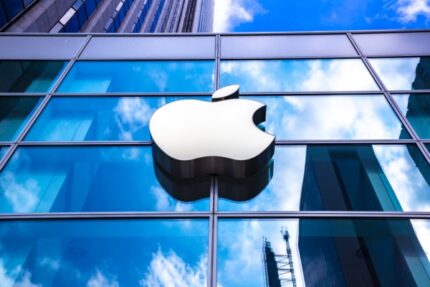Apple (AAPL) has been a haven in this turbulent market, but recent reports say it may not increase production of its new iPhone range because weaker-than-expected demand has caused a minor drop in its stock price.
Apple’s share price has fallen about 4% since those reports. The dip is an indication of the smartphone’s continued importance to the company, despite its efforts to diversify.
Speaking of diversification, are there products or services in Apple’s pipeline that could one day become as important to the company as the iPhone?
Here are two possibilities to consider…

Apple Going into Space?
Satellite/smartphone deals are all the rage in the telecoms industry, with deals aiming to connect satellites directly to either phones or cell towers.
Amazon has partnered with Verizon, OneWeb with AT&T, and Nokia with AST SpaceMobile. T-Mobile has signed a deal to connect smartphones to SpaceX satellites. SpaceX boss Elon Musk also says he has had conversations with Apple.
A move to satellites for Apple would align nicely with its current strategy. The company has started to use more of its own designed chips to increase autonomy over hardware manufacturing. And now, Apple may hope that satellites will give it more control over connectivity to its phones…which would put it in direct competition with wireless carriers like AT&T and Verizon.
Lending credence to the satellite prediction, Apple has already sealed a deal for satellite messaging services with the satellite communications company Globalstar (GSAT).
Apple has said its new iPhone 14 series will include an “Emergency SOS” feature that will allow users to send emergency messages via satellite when out of terrestrial network coverage. This feature will come online in November and initially will be available only in the U. S. and Canada; it will be free for at least its first two years.
The tie-up has pushed Globalstar’s share price up about 55% this year. It was a life-saving deal for the loss-making company, whose stock is only around $1.73 a share, and had revenues of only $124 million in 2021. Apple has warrants to acquire up to 2.64% of Globalstar’s stock at $1.01; in return for its investment, Apple will control 85% of Globalstar’s network capacity.
A buyout of Globalstar seems almost inevitable. The potential gains for Apple could be noteworthy. Keep in mind that Globalstar comes with an existing satellite network plus approval for satellite-based mobile services. That would be another big advantage against iPhone competition.
If Apple’s satellite services also include internet connections in the future, Apple could add another large source of recurring revenue. Internet access in many isolated locations in the world is very valuable.
And even if we focus on just the U.S., an Apple satellite network would be big for the company. If 1% of iPhone users paid $100 a month for internet access via satellite, this service would add close to $1.5 billion to the Apple’s annual revenue, adding to Apple’s bundle of profitable services.
The Next iPhone?
On the hardware side, Apple’s next breakthrough product could be a virtual reality (VR) headset, which could be unveiled as early as this autumn. The company has been moving toward producing this product for a while now, making about a dozen purchases in the fields of virtual and augmented reality over the past six years.
Little is known about this new Apple product, but a “pass-through” video system from Vrana, a start-up company Apple bought in 2017 for $30 million, might be a key feature. Vrana seemingly solved the problem of not being able to see real-world objects while being inside a virtual world. The company repurposed the cameras in its Totem prototype, which had been designed to sense a user’s position, to allow users to also view their surroundings. The whole idea here is that users would be able to see the physical world around them overlaid with digital images.
The VR market remains tiny in comparison to the smartphone market at the moment, and it is currently dominated by Meta Platforms (META). Sales of Meta’s Quest 2 headset reached an estimated 10 million units last year, giving Meta 78% of the VR market, according to research firm IDC.
But based on Apple’s history, it would not surprise me if Apple’s headset quickly does to the Quest headsets what the iPhone did to Blackberry and Nokia.
While few analysts expect AR or VR to go mainstream overnight, researchers at Citi expect that 1 billion people—roughly the number of iPhone users today—will be wearing headsets by 2030. The researchers believe this will translate to a market worth up to $2 trillion in revenue by the end of the decade.
Many things have to be fixed before this happens, however—including improvements in battery power, user interface, and physical comfort for VR and AR headsets. But Apple has done it before—recall that when Apple created the iPhone, its biggest breakthrough was to replace a physical keyboard with a multitouch screen.
Perhaps someday, Apple’s headset will rival and maybe even replace its iconic iPhone.
With these two potential blockbuster products/services coming in the relatively near future, Apple’s stock remains a buy. Just keep slowly accumulating Apple stock during the current bear market. You will be rewarded when Apple’s next big thing comes to fruition.





